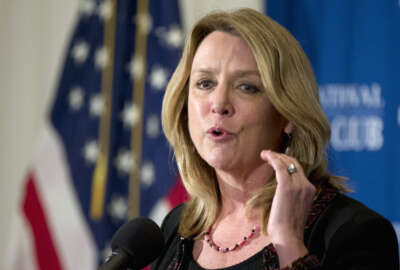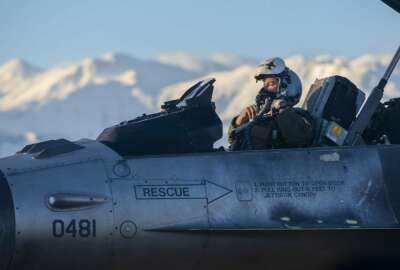
Air Force chief squashes reports that military will force pilots to stay in uniform
Media reports suggesting that the Air Force might require some pilots to stay in uniform beyond their agreed-to separation dates are not true, said the service'...
The Air Force’s top officer on Wednesday attempted to dispose of rumors that the service might involuntarily extend the military service of some of its officers in order to deal with a deepening deficit of qualified pilots.
Gen. David Goldfein, the Air Force chief of staff, said in no uncertain terms that he has no plans to implement stop-loss, a legal mechanism that lets the government respond to military manpower shortages by keeping troops on active duty beyond their agreed-to separation dates. The practice was widely criticized as a “backdoor draft” during the peak of the wars in Iraq and Afghanistan.
“I want to make it as clear as I possibly can — this is not something I am considering,” he said at an event hosted by conservative think-tank the Heritage Foundation in Washington. “It’s a tool in the secretary of Defense’s toolbag to use when we’re in a state of emergency. And we’re not in a state of emergency.”
Stop-loss became a topic of conversation within the Air Force earlier this week when Roll Call reported that such a program was under consideration, citing an interview with Gen. Carlton Everhart, the commander of Air Mobility Command.
Everhart, discussing a planned May summit with U.S. airline executives that was first reported by Federal News Radio, told Roll Call that the Air Force wanted to find a consensus approach to preventing so many of its pilots from leaving the military to fly for airlines, and that he had already told industry representatives, “if we can’t meet the requirements, the chief could drop in a stop-loss — and you need to understand that.”
But as Goldfein correctly pointed out Wednesday, it’s not within the authority of the Air Force chief of staff to authorize a stop-loss. Congress granted that power to the president in 1984, and in 1990, then-President George H.W. Bush delegated it to the secretary of Defense. Since then, it’s been used in both the first and second Iraq wars, including for up to 12,000 soldiers at any one time during Operation Iraqi Freedom.
Goldfein said that while the Air Force’s pilot shortage does not rise to “emergency” proportions, he does consider it a “crisis.” The service ended fiscal year 2016 with 1,555 fewer pilots than it believes it needs to meet its missions.
Congress has already authorized bonus payments of up to $35,000 per year in order to boost retention, but Goldfein said monetary incentives were not enough, and that the pilot exodus pointed to broader problems that would likely take a decade to correct.
“This is a supply-demand mismatch,” he said. “The nation as a whole is producing less pilots than we need in order to service commercial, business and military aviation. I’m the lead advocate as the airman on the Joint Chiefs of Staff, because we’re all affected by this — but we have to look nationally at incentives to increase the supply.”
But Goldfein said the Air Force had its own work to do in order to improve airmen’s “quality of service,” suggesting that many pilots decide to leave the military because budget restrictions have constrained their ability to do what they signed up for — namely, fly airplanes — particularly when they are stationed at units that aren’t currently deployed to an active military engagement.
“Morale is inextricably linked to readiness, and it’s pretty high [overseas] because we’ve been able to invest to keep readiness at a high level,” he said. “Pilots who don’t fly, maintainers who don’t maintain, controllers who don’t control aren’t going to stay with us. There’s not going to be one big program or thing we’re going to do to make pilots stay with us. It’s going to be a hundred little things, so I’ve told our commanders, ‘There’s no such thing as a bad idea. Let’s not waste a good crisis.’”
For instance, Goldfein says he’s authorized squadron commanders to act on their own authority to remove any “additional duties” the service has previously required airmen to perform if, in those commanders’ judgment, there’s no obvious connection between those collateral functions and their squadron’s primary missions.
At an institutional level, the Air Force has already taken steps to eliminate additional duties. Last August, the service did away with or reallocated to civilians 29 out of the 61 functions that all units were previously required to perform, including duties like web page maintainer, public affairs liaison and Defense Travel System administrator.
But the decision to allow individual squadrons and wings to squash administrative tasks that they believe are time-wasters is a significant additional step.
“I got all of our wing commanders together and I said, listen, I want you to leave with two messages. Number one, I trust you. And because I trust you, do not wait for the Chief of Staff of the Air Force to come get after this. You start swinging away at it at your level,” he said. “We have to be thoughtful about it, but I trust the commanders who are entrusted with the mission to get after this. I’m going to swing away at it and I’m serious and passionate about it, but this is going to have to be a full-court press across all elements of the organizational chart.”
Copyright © 2024 Federal News Network. All rights reserved. This website is not intended for users located within the European Economic Area.
Jared Serbu is deputy editor of Federal News Network and reports on the Defense Department’s contracting, legislative, workforce and IT issues.
Follow @jserbuWFED
Related Stories





